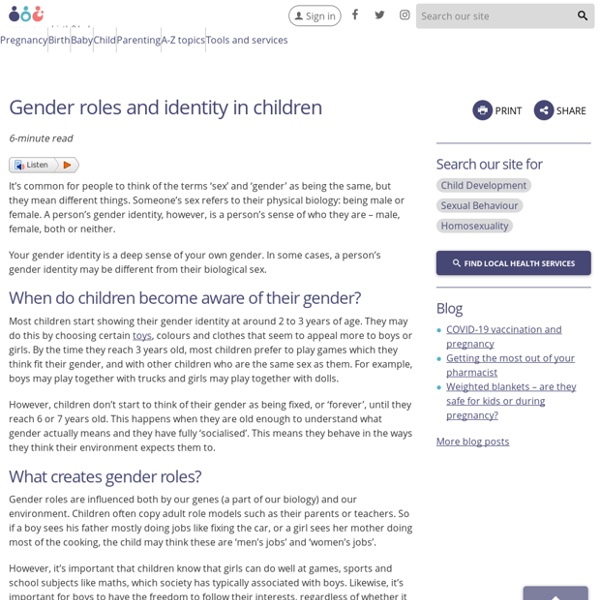Feminine Traits & Stereotypes
Our society has a set of ideas about how we expect men and women to dress, behave, and present themselves. What are gender roles? Gender roles in society means how we’re expected to act, speak, dress, groom, and conduct ourselves based upon our assigned sex. For example, girls and women are generally expected to dress in typically feminine ways and be polite, accommodating, and nurturing. Men are generally expected to be strong, aggressive, and bold.
Gender identity
Gender identity refers to the deep and intimate feeling a person has of themselves. Children begin to understand and express their gender identity early in life. This article discusses how gender identity typically develops and how parents and caregivers can promote healthy development of gender identity and expression in children.
Gender Identity Development in Children
By: Jason Rafferty MD, MPH, EdM, FAAP There are many ways parents can promote healthy gender development in children. It helps to understand gender identity and how it forms. What's the difference between gender and sex? Being a boy or a girl, for most children, is something that feels very natural. At birth, babies are assigned male or female based on physical characteristics.
Children and gender identity: Supporting your child
Children and gender identity: Supporting your child Understand the importance of talking with your child about gender identity and expression — and how to get the conversation started. By Mayo Clinic Staff If your child has questions about gender identity or gender expression, you've probably got questions, too.
Social Learning Theory of Gender by Bandura - ScienceAid
Edited by Jamie (ScienceAid Editor), Taylor (ScienceAid Editor), MaxScience, Sharingknowledge The Social Learning Theory was proposed by Bandura as a way of explaining how children acquire their gender identity based on the influence of other people (particularly their parents). Stages of Learning There are four stages that a child goes through when develop gender behaviour. These are:
Magdalena S. Palencia: Modeling Behavior: Little Versions of Us.
From the moment they are born, children learn by observing their surroundings. Those close to the child are constantly participating in the process of learning. Children will notice those around them and will use them as an example of how to model their behavior.
How Albert Bandura's Social Learning Theory Works
Learning is a remarkably complex process that is influenced by a wide variety of factors. As most parents are probably very much aware, observation can play a critical role in determining how and what children learn.1 As the saying goes, kids are very much like sponges, soaking up the experiences they have each and every day. Because learning is so complex, there are many different psychological theories to explain how and why people learn.
Commentary: What’s behind varying attitudes about gender equality in Singapore
SINGAPORE: For all the progress made in improving understanding between men and women in the road towards gender equality, the biggest hurdle to cross is the one between our ears. Some women’s issues in the news have sparked online debates on gender equality in Singapore – from Facebook to Twitter and Reddit. These online discussions typically raise the usual contentions: Females, without National Service obligations, have an unfair head start at work.
Social Learning Theory Explained
It’s common knowledge that kids often mimic adults and peers. Parents have been delighted but also embarrassed when their kiddo modeled their behavior in public. Social learning theorists have proposed various theories about the complexity of learning. Psychologist Albert Bandura’s Social Learning Theory expanded on the available learning theories of the time. He believed the behaviorists didn’t have a complete theory that social learning required, and neither did the cognitive models.
Albert Bandura's Social Learning Theory
Albert Bandura's Social Learning Theory By Saul McLeod, updated 2016 Social learning theory, proposed by Albert Bandura, emphasizes the importance of observing, modelling, and imitating the behaviors, attitudes, and emotional reactions of others. Social learning theory considers how both environmental and cognitive factors interact to influence human learning and behavior. In social learning theory, Albert Bandura (1977) agrees with the behaviorist learning theories of
What are gender stereotypes and how to stop them?
On 16 June 1963, in the midst of the Cold War struggle between the United States and the Soviet Union to conquer space, Valentina Tereshkova became the first female astronaut. On board the Vostok 6 and at only 26 years old, the Seagull — that was her call sign during the flight — made history and became a symbol of equality between men and women. During the 70 hours and 50 minutes she was away from Earth she circled the planet 48 times. Nothing more and nothing less. Who said impossible? 56 years have passed since the Tereshkova milestone, but even today if someone reads astronaut, architect, engineer or pilot it is more than likely that in their head they see a man.
What Is Gender Identity?
Gender is separate from sex. Although genetic factors usually define a person's biological sex, people determine their own gender identity. This article explores what gender identity is, definitions of various gender identities, and where individuals can find support. What Is Gender Identity?



